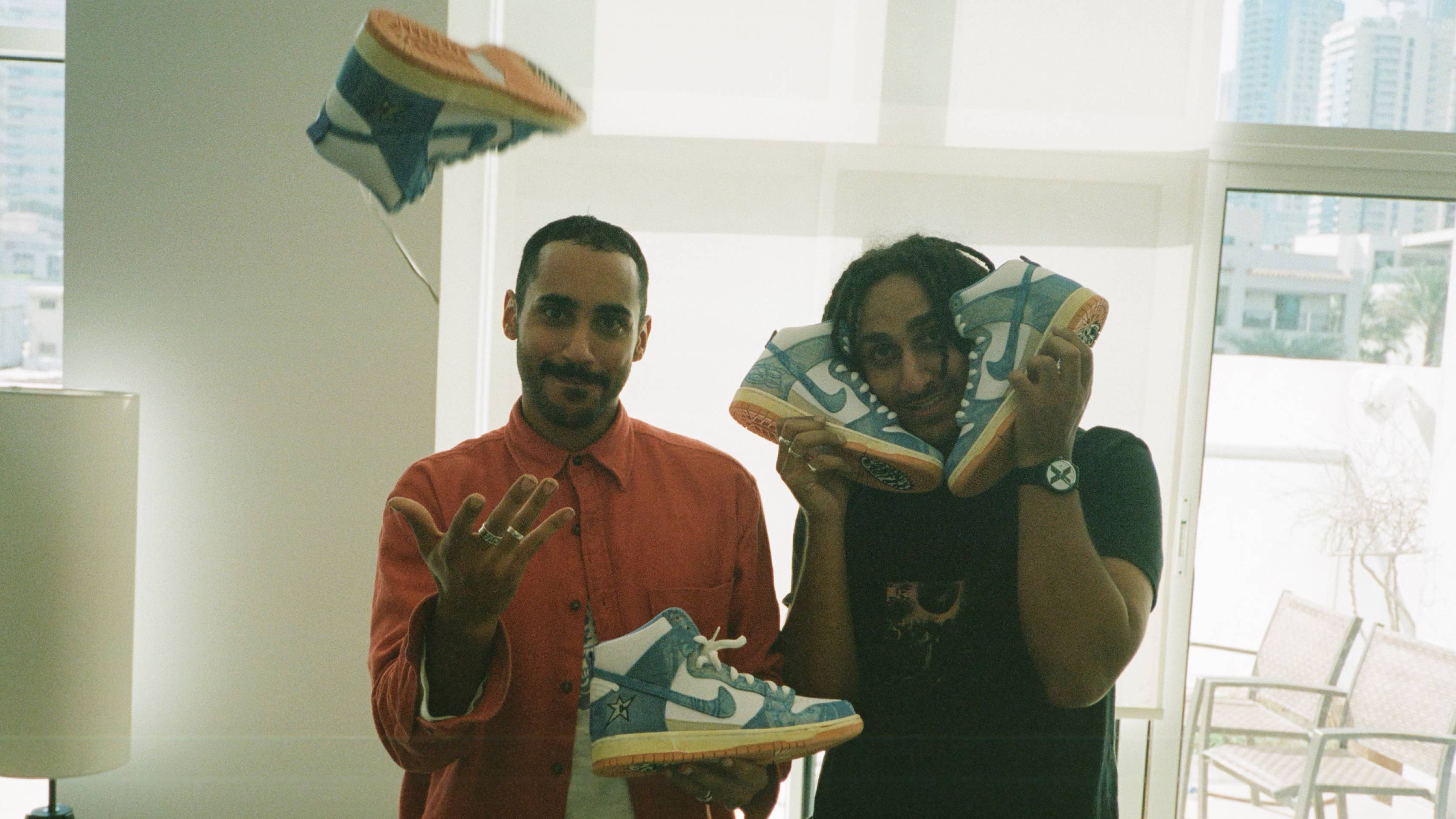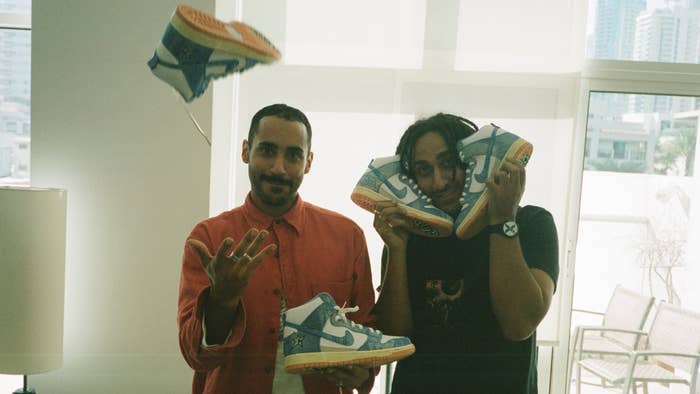
Dr. Hossin Abdeldayem had the answer right away, although he was maybe the least qualified one to provide it, sitting there with his wife and two sons over tea. He is a scientist, not a skateboarder, and aloof to the world of sports footwear.
“Once I started college,” he says, “I stopped doing any sports—except walking.”
Still, he knew what the sneakers needed. So in one shot, with two pencils, he made it, writing out “Nike” in his native tongue and bending the Arabic script to find a balance in the calligraphy, the nun and alif arching high, slanting across like a backward Swoosh. The other letters huddle underneath, giving structure and symmetry. Dr. Abdeldayem’s tea time logo, like the sneakers it’s now affixed to, is an interpretation of American sportswear informed by an Egyptian perspective. But nobody anticipated the design coming from him.
“My dad kind of just always wants to add input. Just being an Arab guy, whatever he says is right,” says Osama, the older of his two sons. “And we usually expect whatever he says to be something not good—same with my mom. But, you know, they’re parents, so you listen to them.”
Osama and his brother, Ayman, are the founders of Carpet Company, a small Baltimore-based skateboard brand known for its screenprinted decks and graphic apparel pieces. Its design language includes bits of Arabic, anonymous images, cartoon-y characters, and flips of classic skate iconography. The mixture renders its catalog bold but not self-serious. It has a mirthful honesty, where a misprint can be embraced and a smudge of ink is a warm human touch. The work is part time for both—Carpet’s profile has risen steadily since its launch in 2015, but the brothers have day jobs.

“They’re so involved within it, I’m afraid they will leave the jobs they have,” their father says. “Both of them have very good jobs.” Ayman, like their father, works at NASA, Osama at a utility company in Baltimore.
Despite the limited time they can devote to it, Carpet has become a darling in the world of skateboarding. Fader ran a gushing profile in 2018. Skate outlet Jenkem documented their process in 2019. Supreme started stocking their clothes. So did spots as far as Australia and Japan. Somewhere in there, a longtime Nike employee named Rob Sissi reached out. At their first meeting, reps from the Swoosh’s skateboarding division, Nike SB, surprised Ayman and Osama with how much they knew about Carpet’s operation. Those talks resulted a year and a half later in a collaborative shoe bearing scans of screens they print with, hidden messages, and their father’s handwriting.
The Carpet Company shoe uses the Nike SB Dunk High for its base, a skateboarding-specific style of the enduring Dunk basketball sneaker from 1985. It adds a brew of graphics in light blue across the upper that wears away to show yellow leather with a fez-wearing character underneath. The heels have peel-off sections, the left revealing a note on the project’s origin (“Brought to you by the habibis at Carpet Company”) and the right revealing the calligraphy of Dr. Abdeldayem. The skate brand’s name is embroidered in Arabic on the inside of the collar.
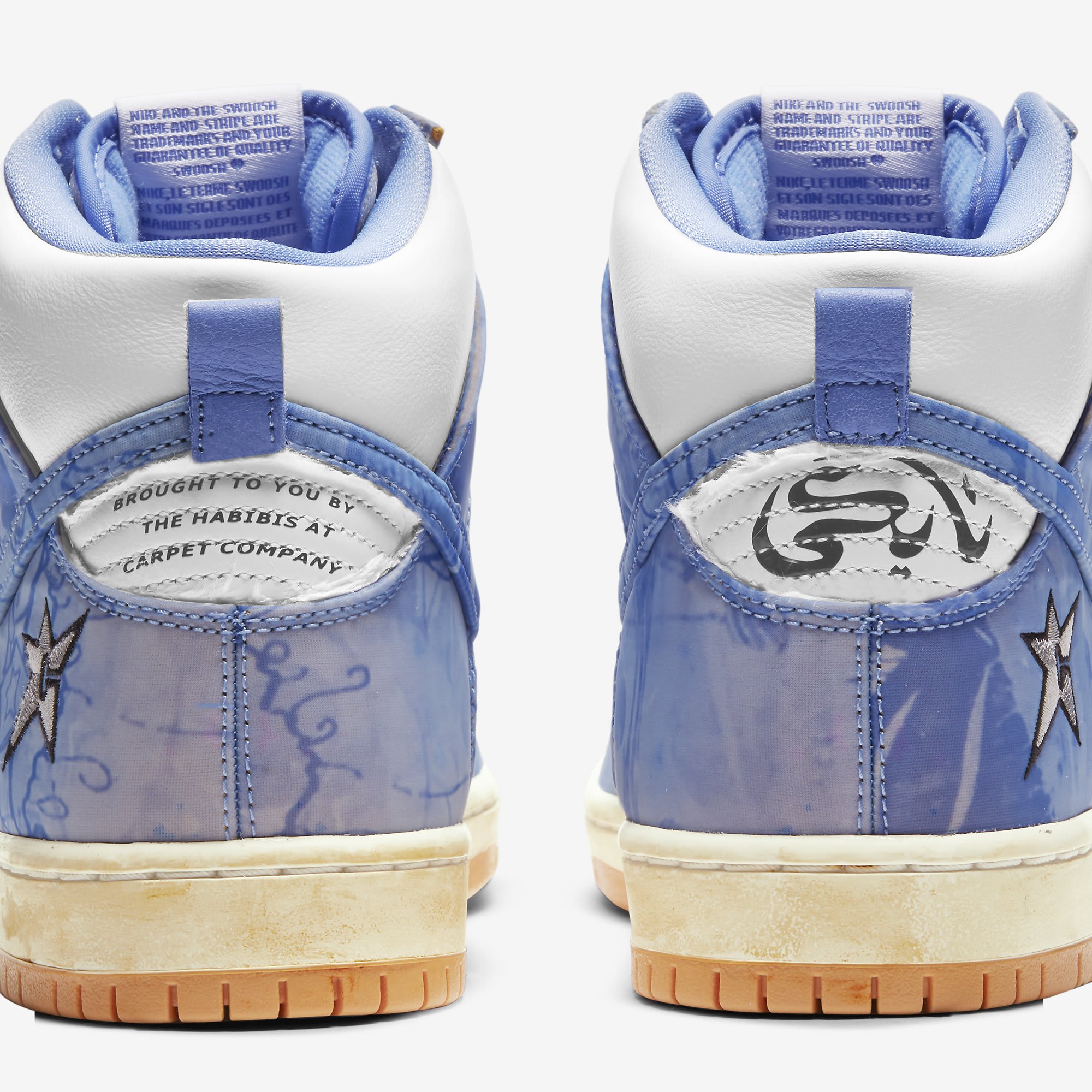
The Carpet Company x Nike SB Dunk High, retail price $125, had a preliminary raffle release online and in Baltimore this past week. Available there was a special promo box, made to look like a can of paint thinner. (Ayman says they had to take out a loan to get the expensive boxes made.) The shoes will arrive globally at skate shops on Feb. 26 and Nike’s SNKRS app on March 2. A US release will follow via skate shops on March 9 and the US SNKRS app on March 12. It is the biggest release in the short story of Carpet, one acquainting the brand to zealous sneaker consumers. It’s a tribe Ayman and Osama, who collected and sold SB Dunks as teenagers, are well acquainted with.
“We went through a really big point where we sold so many shoes in Maryland,” Ayman says. “We were, like—“
“Known for selling Dunks,” Osama says, finishing his sentence.
Back then, in the MySpace days, the brothers would stay up all night on eBay waiting for auctions on rare sneakers to end at odd hours when nobody would be watching and bidding. They accrued SB Dunk staples like the Tiffany and the Buck colorways. Osama remembers learning how to do switch tre flips in a grocery store parking lot while wearing the orange Supreme x Nike SB Dunk High. The brothers skated for a Washington, DC, shop called Palace 5ive, which allowed them access to certain shoes without having to wait in line.
Their tales of flipping shoes from this era are distinctly DC, too. Ayman recalls selling a pair to Wale. His brother once helped another local get their footwork sorted for a pressing engagement.
“I remember selling a pair of Stüssy Dunks for $200 in front of my parents’ house and it still blows me,” Osama says, explaining that the eager customer needed footwear for a go-go outing that night.

Their history in sneakers, particularly those from Nike SB that converted so many customers into collectors in the early 2000s, informs the Carpet Company Dunk collaboration. What made those Nike SBs special was that they allowed a unique kind of expression through shoes, using collaborators and colorway references to tell stories. It was a new strain of sportswear that allowed a different set of voices to speak through a giant business like Nike. The Carpet Company shoe is aware of this—reverent enough of the long history of the Dunk to include classicist elements, but eager enough to add to that history with idiosyncratic touches.
Years before Nike ever reached out to work with them, Ayman and Osama had traded Dunk ideas, imagining what they would do if they could create one.
“Not that it would ever happen, but how cool it would be if it ever happened,” Osama says of those aspirational design sessions.
Once they finally did get the chance to do it through Carpet Company, the ideas wouldn’t flow.
“When Nike gave us the opportunity, our minds went blank,” Ayman says.
At first, they wanted to do a set of heat-activated sneakers that changed color under the sunlight. There would be multiple colorways, sold blind-box-style so that the buyer wouldn’t know which shade their shoes would turn to in the heat. They abandoned that idea when they learned that Civilist, a store in Berlin, was planning a heat-activated Dunk for fall 2020. Carpet Company was aiming to do an SB Dunk Low and an SB Dunk High at one point, but had to pare it down to just the High. Ayman also had the idea to do a retro of the Zoom FC, a Nike SB shoe that never enjoyed the same status as the Dunk, but it was too expensive for factories to make, as the model isn’t regularly produced.
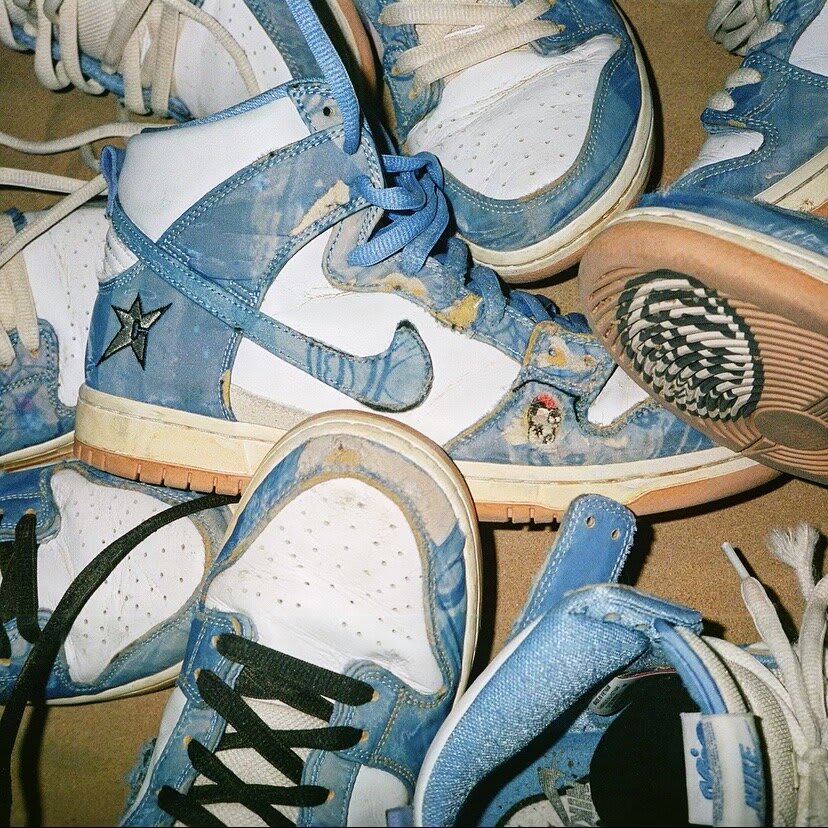
Their eventual shoe of choice was still not an easy one for Nike from a production standpoint. The yellow leather base has ink splatters and blue graphics printed on top that wear away.
“The emulsion that we use to make screens is actually a blue emulsion, the chemical we use to make screens to screenprint on,” Osama says. “So we literally just scanned the screens, and that’s basically the blue.”
The blue layer was added partly to incorporate Carpet’s screens and partly because, according to Nike, yellow sneakers don’t sell. The yellow was important to have, though, Carpet’s signature color being a crisp, muddy saffron.
“The Carpet Dunk is probably one of the most complex Dunks to come out in a long time,” says Stephen Pelletier, a designer who worked on the shoe for Nike SB. “There’s a lot that’s going on there. There’s two layers of graphics, there’s the screen material, there’s a whole bunch of stuff.”

Detailed as it is, the sneaker is meant in one way as a tribute to the most standard Nike Dunks there are, the two-toned 1985 versions that introduced the shoe. The colorblocking on their shoe uses the same equation as those originals. Ayman and Osama built the Carpet Dunk on a vision of the college-themed ’85 pairs, referencing colorways like the Kentucky Wildcats one in white and blue. Their update makes an iconic design their own, pollinating it with an Egyptian cheekiness, scribbling Arabic on it, and adding unique inflection to one of Nike’s most recognizable products. Some of the changes caused pause at the sneaker company.
“Definitely, when it came to the Arabic, Nike was nervous as hell because there’s a history there with the Air Bakin’ shoe,” Pelletier says, referring to the controversy around a late-’90s Nike sneaker with a logo on the back that looked like the word “Allah” in Arabic.
Some of the Arabic writing that appeared on the mock-ups of the Carpet shoe was toned down. An early version had the text “Carpet Company sucks” in Arabic, a phrase used on their gear, but Nike had them edit out the “sucks” part. Other playful teasing was erased. The insole originally had a message from their mother in schoolgirl handwriting proclaiming the shoe horrible—listing out the many reasons not to buy it—then deeming it a good shoe, as her kids designed it, then ultimately deciding it was a bad shoe. The message didn’t make it; in its stead is Carpet’s Moroccan character. Nike was selective in what it allowed to be written.
“They were really hesitant, which I fully understand,” Osama says. “But the thing is, all the Arabic we had, we actually had the translations as well.”
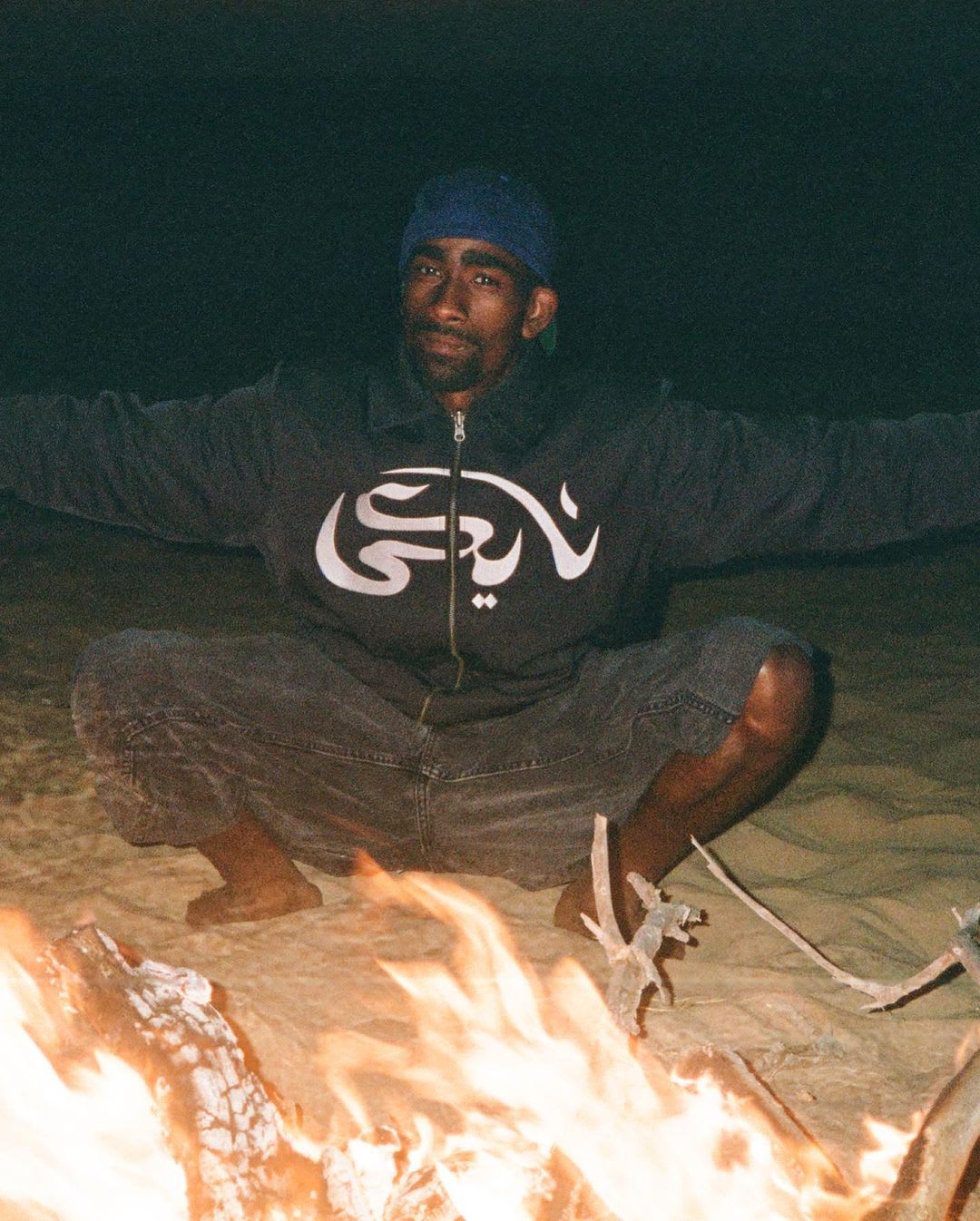
The most prominent Arabic used in the collection, the calligraphy printed across the front of two apparel pieces and on the right sneaker’s heel, has some potential to offend. The word looks like an Arabic curse word, the past tense of a verb for fornication. Ayman and Osama’s parents didn’t see the resemblance until it was brought to their attention.
“They just started busting out laughing,” Ayman remembers. Dr. Abdeldayem, who does not curse, says the two words aren’t quite the same.
The writing across the shoes and clothes made by Carpet and Nike SB gives representation to a language that usually doesn’t pop up on limited-edition items. For Pelletier, who worked at Nike from 2008 until the end of last year, this is in the spirit of SB, a division at the gigantic sneaker maker that is a home for people who saw themselves as distinct from athletes in more traditional sports. The designer views SB product as potentially illuminating, able to throw light on scenes and people that aren’t usually centered in American pop culture.
“I think one of the raddest things that came out of the Carpet project is the piece with the Arabic across the chest,” he says, mentioning a jacket they’re selling that has a large print of Dr. Abdeldayem’s calligraphy on the front. “Did you ever think Nike would come out with something like that? I didn’t.”
When they first visited Nike’s headquarters in Oregon to work on their collaboration, Ayman and Osama had intentions to bring even more of their Egyptian background into the project. They wanted to do a Nike SB fez and galabeya, a traditional Egyptian gown, but the timing didn’t work out when the idea resurfaced ahead of the shoe’s launch. The garments endure in the imagery around the Carpet x Nike SB Dunk project. In one promotional clip, Osama slides down a rail wearing a fez, a crisp white galabeya, and the sneakers. Ayman, wearing the same, save for his more traditional footwear, chases after his brother, throwing a shoe at him.
Carpet Company’s items do not overwhelmingly reference the Arab identity of their makers, but it’s an important part of their body of work. There are ankhs and a shirt that reads, “I miss my habibis.” Their father is happy to see the brothers’ North African roots represented in the brand. He recalls Ayman and Osama as children being less enthused in one instance about dressing Egyptian.
“I remember when they were like 5, 6, years, I bought some galabeyas for them when I was in Egypt, just for the fun of it,” Dr. Abdeldayem says. “I thought that they would like it. I remember that they did not like it at the time.”
Now, though he has reservations about Carpet interfering with their day jobs, the father sees the brand’s value as a transmitter of culture. He likens Carpet Company’s projects, like a shoe release drawing Nike toward the Nile, to the diverse backgrounds he encounters in his career at NASA. In his office, people are encouraged to share traditions, food, and holidays, adding texture to their understanding of each other.
“It brings richness into the type of work we do,” Dr. Abdeldayem says.
So will he become a participant in sneaker culture now that his sons are so directly involved? Nike was around in Egypt before he left the country for the US in 1977, but it was a brand for the elite. The sneakers were relatively expensive. He jokes that the price on the Carpet Company x Nike SB Dunk High might still be prohibitive for him.
“It’s too expensive for me to afford it,” he laughs, claiming that his sons told him he could only get a pair if they had any left over after the Baltimore release.
Ayman and Osama ensure in a separate conversation that their whole family, Dr. Abdeldayem included, will be taken care of on the limited sneaker release. In their basement, they say, there is a box for him labeled baba.

